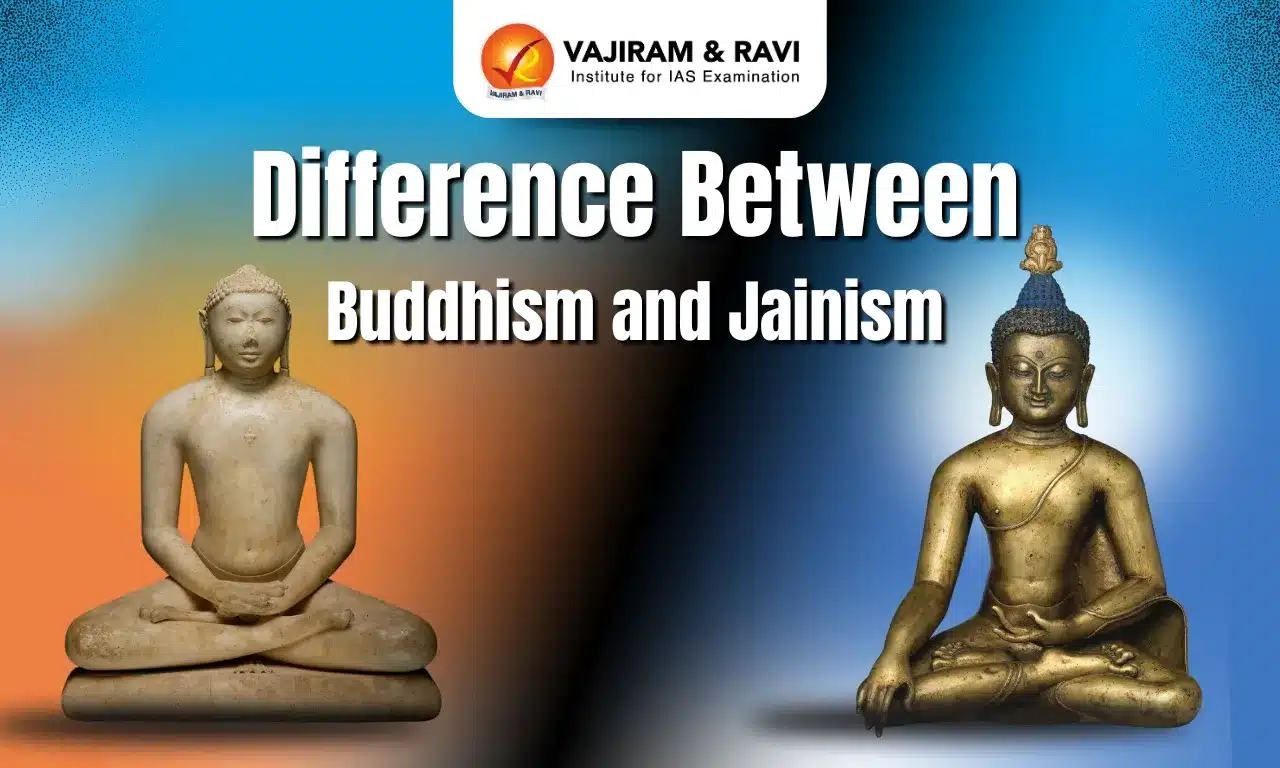Jainism vs Buddhism: The prevalent social, economic, and religious circumstances during the sixth century B.C. gave rise to new religious churning in Indian society. The Vedic ritualistic, orthodox ideas and the prevalence of rigid caste realities were coming under increasing attack during this period. As a result, numerous heterodox religious movements eventually emerged. Amongst them, Buddhism and Jainism were the most important ones that successfully evolved into the well-organised popular religions.
Differences between Jainism and Buddhism
The emergence of Jainism and Buddhism shares some similarities in their principles; however, they differ significantly in some fundamental aspects.
Founder of Jainism and Buddhism
- Buddhism: Buddhism was founded by Siddhartha Gautama (‘the Buddha’).
- Jainism: There are 24 Tirthankaras who are credited with founding and developing Jainism and its philosophy; however, Parsvanatha and Mahavira are more noteworthy owing to their historical records and effect on the two main sects of Jainism.
Core Teachings
| Concept | Buddhism | Jainism |
| Basic Doctrines |
- Four Noble Truths:
- The Eight-Fold Path:
|
- Pancha Mahavratas:
- Triratnas: According to Jainism, a person can achieve "moksha" by leading a life of purity, virtue, and renunciation. The following principles (triratnas or ratnatraya) can be followed to achieve moksha (nirvana):
|
| Belief in Soul |
- Buddhism denies the concept of self (jiva) or soul (atman), proposing the concept of no-self (anatta) instead. - Buddhism does not believe in the transmigration of the soul either. |
- Jains believe in the existence of an eternal Jiva (soul). - They believe in the transmigration of the soul. |
| Non-violence doctrine |
- Buddhism takes a moderate path to non-violence. It prohibits violence but is not as strict as Jainism. - For example, it even permits eating animal flesh, if necessary or as part of the local diet. |
- The doctrine of nonviolence ('Ahimsa') is being strictly followed by Jainism. - For instance, Jain vegetarianism is based on the idea that no animal should be harmed. - They also prohibit agriculture because they believe that it can kill insects and pests. |
| Salvation |
- Buddhism advises its Upasakas to follow the middle path to attain salvation (Nirvana). - Nirvana is possible during one’s own life through the practice of detachment from worldly desires and ignorance. - According to Buddhism, it is possible for both normal men and women to attain salvation. |
- Jainism advises the practice of strict asceticism to attain salvation, that is Kaivalya. - According to Jainism, salvation is possible only after death. - According to Jainism, women and male householders cannot attain salvation. |
| The existence of God | - The Buddha neither accepted nor rejected the existence of God. He was more concerned about the individual and his actions. |
- Jainism recognises the existence of God. - For example, in Jainism, pantheons of gods, including the Brahmanical gods, are worshipped. |
| Karma |
- The concept of 'karma' law is highly valued in Buddhism. - This law states that past acts determine the present. |
- They also believe in Karma. - According to Jains, karma is a real substance that permeates the entire universe. - The actions of the soul draw karma particles to the soul. |
| Philosophical concepts |
- Madhyamika: Also known as Sunyavada and was systematised by Nagarjuna (2nd century A.D) - The name of this school comes from Buddha’s famous ‘middle position’ (madhyama pratipad). - The middle position is the rejection of the extreme metaphysical positions of ‘is’ and ‘is not’ (Sasvatavada and Uchedavada). - Thus it becomes the no-position (transcendental and inexpressible) and they used the word ‘Sunyata’ to explain it. |
- Anekantwada: Realistic and relativistic pluralism is what the doctrine of the manyness of reality proposes. A thing can have an infinite number of unique characteristics.
- Syadvada: The doctrine of Jaina metaphysics, which is expressed by the word syat (Sanskrit: "maybe"), holds that all judgements are conditional and valid only under specific circumstances, senses, or conditions.
|
Schools
Buddhism:
- Mahayana Buddhism (The Great Vehicle)
- Vajrayana Buddhism (The Way of the Diamond)
- Theravada Buddhism (The School of the Elders)
Jainism:
- Digambara
- Svetambara
Position of Women in Jainism vs Buddhism
Buddhism:
- The Buddha initially opposed allowing women to join the Sangha.
- But after repeated requests from Mahapajapati Gotami, his foster mother, and his chief disciple Ananda, he finally agreed to bring them in.
- Hinayana and Mahayana do not give high regard to women. They consider that the woman’s body is not suitable for enlightenment (Nirvana) or becoming a Buddha.
- But Vajrayana (and Tibetan Buddhism) places high importance on women, manifested by the female Bodhisattvas, such as Tara, Manjushree, etc. It provides equal opportunities to men and women.
Jainism:
- Jainism gives women a central role in its ethical and spiritual patterns. For example, the fourfold community that is the foundation of Jain's daily life includes laywomen as well as laymen, nuns, and monks.
- Among Svetambara sects, we can also find female mendicants, other than males.
- Traditional sources reveal several distinguished women who played important roles in the tales of the Jinas, and goddesses are significant cultural and religious figures.
- In addition, the soḷa sati, or 16 virtuous women of Svetambara, are female role models whose stories highlight desirable religious qualities.
Views on the Varna System
- Buddhism: Buddhism condemns the Varna system.
- Jainism: Jainism does not condemn the Varna system.
Canons
- Buddhism: The Buddhist canon (collection of teachings) is divided into tripitakas (three sections), namely: Sutta Pitaka, Vinaya Pitaka, and Abhidhamma Pitaka. All these canons are in the Pali language.
- Jainism: Jain literature is classified into two major categories: Digambara literature and Svetambara literature.
- The Digambara canon, or Siddhanta, comprises numerous texts. Two are believed to be all that remains of the original Purvas, composed in the 2nd to 3rd centuries.
- The canons of Svetambara are composed of twelve Angas, twelve Upangas, ten Prakirnakas, four Mulasutras, six Chedasutras, and two Chulika sutras.
Art and Architecture of Buddhism and Jainism
- Architecture:
- One can observe elaborate architectural and sculptural styles in Buddhism, such as Gandhara Art, Mathura Art, and Amravati Art.
- Unlike Buddhism, Jainism did not create any distinctive style of architecture; rather, Jains adopted local architectural traditions wherever they went.
- Due to its extensive patronage, Buddhist architecture in India is more widespread.
- Both Buddhists and Jains built rock-cut caves, but Jains caves are smaller.
- Paintings:
- Buddhism has been able to create distinctive paintings based on Bodhisattvas and Jataka tales. Paintings in Jainism, on the other hand, could not evolve as extensively as in Buddhism.
- For example, Padmapani and Vajrapani Bodhisattva paintings at Ajanta and Sittanavasal cave paintings of Jainism.
- The miniature painting also evolved in India due to Buddhism, such as the Pala miniature. However, Jainism has also contributed to the miniature paintings in India.
- Literature: The Jain canons were written in Ardhamagadhi (Prakrit), while Buddhist canons were written in Pali.
- Non-canonical literature of both Buddhism and Jainism is written in Sanskrit and other languages.
- The Buddhist literature is more extensive than that of Jainism due to royal patronage and contributions by Buddhist monks.
Spread of Jainism and Buddhism
- Patronage: Royal patronage was the deciding factor that helped Buddhism spread inside and outside of India, whereas Jainism did not have such advantages.
- Both Jainism and Buddhism were given patronage by traders and artisans.
- Spread:
- Due to the concept of the moderate path, Buddhism proved to be more adaptable as compared to Jainism, which adheres to a strict code of conduct and non-violence principles.
- Unlike Buddhism, Jainism never had religious leadership beyond the frontiers of India because the orthodox Jains did not travel by vehicle.
While Buddhism has practically vanished from India, the land of its birth, Jainism is still a prominent religion, albeit in small numbers.
Last updated on November, 2025
→ Check out the latest UPSC Syllabus 2026 here.
→ Join Vajiram & Ravi’s Interview Guidance Programme for expert help to crack your final UPSC stage.
→ UPSC Mains Result 2025 is now out.
→ UPSC Notification 2026 is scheduled to be released on January 14, 2026.
→ UPSC Calendar 2026 is released on 15th May, 2025.
→ The UPSC Vacancy 2025 were released 1129, out of which 979 were for UPSC CSE and remaining 150 are for UPSC IFoS.
→ UPSC Prelims 2026 will be conducted on 24th May, 2026 & UPSC Mains 2026 will be conducted on 21st August 2026.
→ The UPSC Selection Process is of 3 stages-Prelims, Mains and Interview.
→ UPSC Result 2024 is released with latest UPSC Marksheet 2024. Check Now!
→ UPSC Prelims Result 2025 is out now for the CSE held on 25 May 2025.
→ UPSC Toppers List 2024 is released now. Shakti Dubey is UPSC AIR 1 2024 Topper.
→ UPSC Prelims Question Paper 2025 and Unofficial Prelims Answer Key 2025 are available now.
→ UPSC Mains Question Paper 2025 is out for Essay, GS 1, 2, 3 & GS 4.
→ UPSC Mains Indian Language Question Paper 2025 is now out.
→ UPSC Mains Optional Question Paper 2025 is now out.
→ Also check Best IAS Coaching in Delhi
Jainism vs Buddhism FAQs
Q1. With regard to the foundation, what is the difference between Buddhism and Jainism?+
Q2. What is the difference between Buddhism and Jainism with respect to belief in the soul?+
Q3. How do Buddhism and Jainism differ in their belief in the existence of God?+
Q4. To attain salvation, what is the difference between Buddhism and Jainism?+

















